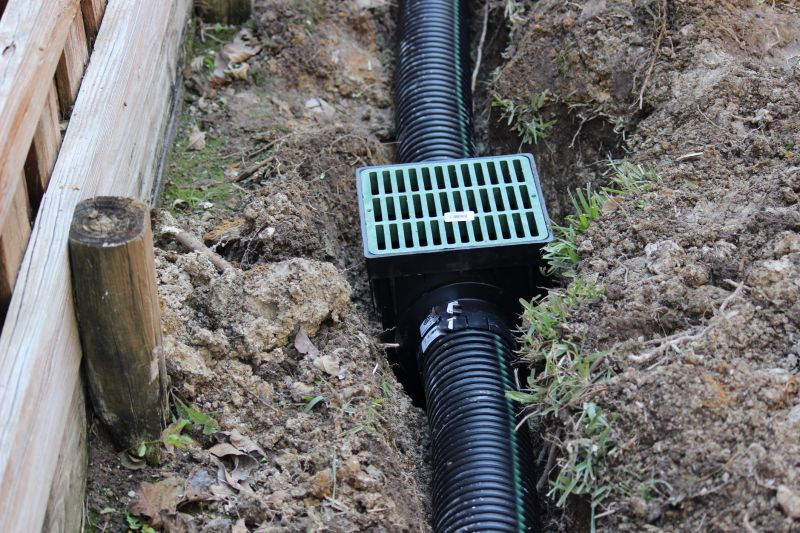Top Choices for Perimeter Drainage System Installation Projects
Browse through the most recommended products to enhance your drainage setup and prevent water accumulation.
 Perimeter drainage system installations are essential for managing excess water around structures, helping to prevent water intrusion and foundation damage. These systems typically involve a combination of drainage pipes, gravel, and protective barriers that work together to channel water away from the foundation. Proper installation of these components is crucial for effective water management and long-term structural integrity.
Perimeter drainage system installations are essential for managing excess water around structures, helping to prevent water intrusion and foundation damage. These systems typically involve a combination of drainage pipes, gravel, and protective barriers that work together to channel water away from the foundation. Proper installation of these components is crucial for effective water management and long-term structural integrity.
Top Overall Option
Perimeter Drainage Pipe System
A flexible, perforated drainage pipe system made from durable high-density polyethylene offers a versatile solution for perimeter drainage. Its design allows for easy installation, effective water collection, and reliable water diversion away from foundations, making it a popular choice for various property types.
Types of Products For Perimeter Drainage System Installations
Perforated Drainage Pipes
Designed with tiny holes to collect and channel water efficiently around foundations and landscape areas.
Solid Drainage Pipes
Non-perforated pipes used for directing water away from specific points or as part of a larger drainage network.
Drainage Pipe Fittings
Connectors, elbows, and couplings that facilitate proper alignment and directional changes in drainage systems.
Drainage Gravel and Aggregate
Crushed stones and gravel used to surround pipes, aiding water flow and preventing clogging.
Filter Socks and Sleeves
Protective coverings that prevent soil and debris from entering perforated pipes, maintaining system efficiency.
Catch Basins and Grates
Entry points for surface water collection that connect to underground drainage pipes.
Drainage System Accessories
Clamps, connectors, and sealants that ensure secure and leak-proof system assembly.
Slope Stabilizers
Supports and stabilizes trench slopes to prevent collapse during installation.
Waterproof Membranes
Barrier materials used to protect foundations and drainage components from moisture intrusion.
Flexible Drain Pipe Sections
Sections that can bend and adapt to irregular trench layouts, simplifying installation.
Popular Choices
Widely used for perimeter drainage, these pipes facilitate water collection and redirect flow efficiently.
Commonly used as a bedding material around pipes, helping to improve water flow and prevent clogging.
Essential for creating seamless connections and directional changes within the drainage system.
Popular for surface water collection, these basins connect to underground pipes to manage runoff.
Protect perforated pipes from debris, ensuring the longevity and efficiency of the drainage system.
Allow for adaptable installation around complex layouts or obstacles in the trench.
Used to secure fittings and prevent leaks within the drainage network.
Help maintain proper trench slopes for optimal water flow and prevent collapse.
Provide foundation protection and prevent moisture intrusion in drainage zones.
Facilitate the final discharge point for water diverted from the perimeter system.
Selecting the right products for a perimeter drainage system involves understanding the different types of drainage pipes, fittings, and accessories available. From perforated pipes designed to collect and redirect water to specialized filters that prevent clogging, there is a wide range of options suited for various property layouts and soil conditions. Ensuring compatibility between components and considering ease of installation are important factors in creating an effective drainage setup.
Durability and material quality are also key considerations. Many products are made from high-density polyethylene or other sturdy plastics that resist corrosion and physical damage. Additionally, features like flexible joints, ease of cutting, and secure fittings can simplify the installation process and improve system performance. Proper planning and product selection can help homeowners and contractors achieve a reliable drainage solution tailored to their specific needs.
While choosing products, it is advisable to consider the overall system design, including the placement of catch basins, outlet points, and the slope of the drainage trench. Consulting with drainage specialists or reviewing product specifications can aid in designing an efficient system. Regular maintenance and inspection of installed components will also help maintain optimal water flow and prevent potential issues over time.
Key Buying Considerations
- Determine the specific water management needs based on property layout and soil conditions.
- Choose the appropriate pipe diameter to ensure adequate water flow capacity.
- Select perforated versus solid pipes depending on whether water collection or diversion is the priority.
- Consider the material durability, especially resistance to corrosion and physical damage.
- Evaluate the ease of installation, including flexibility and compatibility with existing systems.
- Assess the quality and type of fittings required for secure connections and system integrity.
- Plan for proper trench slope and drainage outlet placement to optimize water flow.
- Use protective filters or socks on perforated pipes to prevent clogging from debris.
- Incorporate gravel or aggregate bedding to enhance drainage efficiency and stability.
- Check for compatibility with other drainage accessories and system components.
- Consider future maintenance needs and accessibility of installed components.
- Verify that the selected products meet relevant building codes and standards.
- Estimate overall project costs, including materials and potential labor or professional assistance.
- Review product warranties and manufacturer support for long-term peace of mind.
- Ensure that the system design minimizes potential for clogging or blockages over time.
This content contains affiliate links. We may earn a commission if you purchase through these links, at no additional cost to you.
